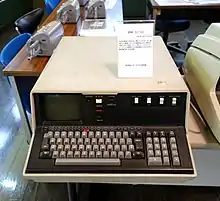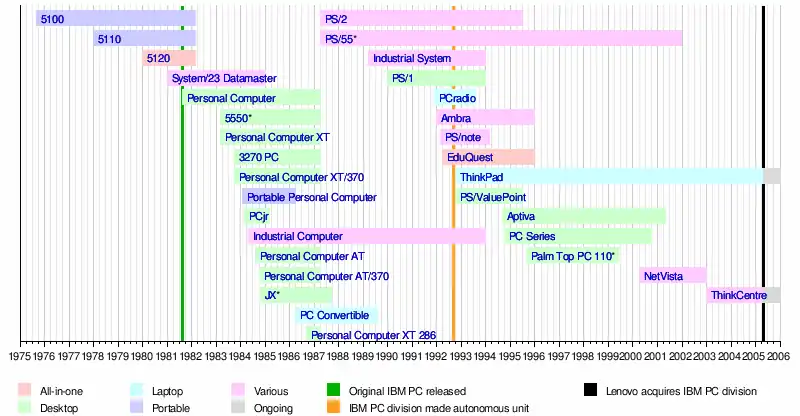 | |
| Release date | January 1978 |
|---|---|
| Discontinued | March 1982 |
| CPU | IBM PALM processor |
| Memory | 16–64 KB RAM (with 16 KB iterations) |
| Display | 5-inch CRT |
| Graphics | 64x16 characters |
| Predecessor | IBM 5100 |
| Successor | IBM 5120 |
The IBM 5110 Computing System is the successor of the IBM 5100 Portable Computer.
The IBM 5110 was announced in January 1978 (a little over 2 years after the introduction of the IBM 5100). Its main differences were support for more I/O devices (floppy disk drives, IEEE-488, RS-232) and a character set (EBCDIC) which was compatible with other IBM machines. These improvements made it partially incompatible with the IBM 5100.
Variations
Three variations of the IBM 5110 were built:
- IBM 5110 Model 1 (with a built-in QIC DC300 tape drive of 204 kB)
- IBM 5110 Model 2 (without the QIC tape drive)
- IBM 5110 Model 3 - also designated as the IBM 5120 (with two built-in 8-inch 1.2 MB floppy disk drives)
Description
The 5110 featured the same housing as the 5100 (although the colors were different), which contained an IBM PALM processor, a keyboard and a 1,024-character display screen. Main memory held 16, 32, 48 or 64 KB of data, depending on the unit. Offering either magnetic tape or diskette storage, the Model 1 could store as much as 204,000 bytes of information per tape cartridge or 1.2 MB on a single 8" diskette; the Model 2 allowed only diskette storage. Up to two IBM 5114 diskette units, each housing a maximum of two 8" diskette drives, could be attached to the 5110 for a total online diskette capacity of 4.8 MB. The IBM 5110 Model 3 allowed only one external IBM 5114 diskette unit. IBM did not offer a LAN or hard disk drive for these systems. However, in 1981 Hal Prewitt, founder of Core International, Inc invented and marketing the world's first and only hard disk subsystems and "CoreNet", a LAN used to share programs and data for the IBM 5110 and 5120 systems.[1][2]
An IBM 5103 printer and an external IBM 5106 auxiliary tape unit (Model 1 only) were available as options from IBM.
Citing the easy use of his new system, Jeff Grube, vice president of Punxsutawney Electric Repair (who received the first IBM 5110 on February 2, 1978), said: "If you can type and use a hand-held calculator, you have all the skills necessary to operate a 5110."
Programming languages
The 5110 was available with either APL or BASIC—or both—programming languages. Machines that supported both languages provided a toggle switch on the front panel to select the language.
In 1984, Core International, Inc introduced PC51, software that allowed 5100 Series computer programs written in BASIC to run unmodified on the IBM PC and compatibles under PC DOS and share programs and data on CoreNet, the LAN for all these models.
5110 Software
The 5110, designed by the Global Software Development team at IBM Rochester in Rochester, Minnesota,[3] was aimed at GSD's traditional commercial market. The machine was brought in only 90 days from conception to production. It achieved this short timescale under the management of Bill Sydnes, who as a member of Bill Lowe's taskforce later did much the same for the IBM PC.[4] As a business system, IBM offered a number of basic accounting software for a small business. However, companies such as Core International, Inc designed and supported a wide assortment of application programs.
Model 3
The IBM 5110 Model 3 (also known as the IBM 5120 Computing System) was the desktop version of the 5110.
The 5110 was withdrawn from marketing in March 1982 but IBM continued to support the series until the mid 80s.
Timeline
| Timeline of the IBM Personal Computer |
|---|
 |
| Asterisk (*) denotes a model released in Japan only |
References
- ↑ "Save IBM 5110/20 from junk yards of the world" (PDF). Core. Archived from the original on Jul 21, 2011. Retrieved Mar 31, 2010.
{{cite web}}: CS1 maint: unfit URL (link) - ↑ "1982 CORE Newsletter" (PDF). Core. Archived from the original on Mar 5, 2012. Retrieved Nov 18, 2016.
{{cite web}}: CS1 maint: unfit URL (link) - ↑ Cf. IBM 5110 Computing System, IBM Archives website
- ↑ IBM 100 - Icons of Progress - The PC Team
- Notes
- IBM 5110 Computing System IBM Archives. Retrieved 10-19-2011.
- Core 5110/20 Hard Drives
- Mercer, David (1987, 1988). IBM: How the World's Most Successful Corporation is Managed, Kogan Page Ltd. ISBN 978-1-85091-287-3. ISBN 978-1-85091-637-6.
- 1984 Core PC51 Users Manual
- 1984 Core PC51 Media Release